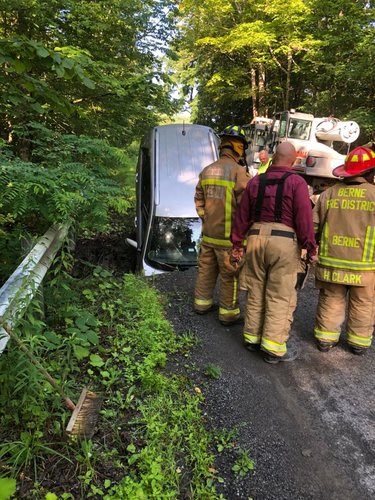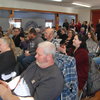Minivan upended: Who’s at fault?
BERNE — On Thursday morning, Aug. 1, a 71-year-old Middleburgh woman was driving west on Bridge Road in Berne when she saw a “road closed” sign ahead, according to a police report.
The woman, Joann Hotaling, continued past the sign and drove into a deep excavated hole, her Kia Sorento landing on its nose, the report said. The hole had been excavated by the Berne Highway Department for road repairs.
Further, the police report says she “stated the sun created a glare in the roadway … she did not see the gap in the roadway being repaired by construction, and drove directly into the section of the roadway that was missing.”
Berne Highway Superintendent Randy Bashwinger maintains that the highway department followed the proper protocol when closing the section of Bridge Road, and says that Hotaling admitted fault.
Hotaling adamantly told The Enterprise that she did not admit fault.
“I just want to say, I hope they learned their lesson,” Hotaling said, of the highway department.
Hotaling has driven on Bridge Road before, she told The Enterprise on Wednesday. On Aug. 1, she was driving to Albany to pick up her daughter from the dentist’s office, she said.
It was the first time she saw the single sign on the road, reading “Road Closed, Local Traffic Only,” said Hotaling. There were no flaggers, she said, only a sawhorse along with the sign. Because it stated “local traffic only,” she said, she decided to continue on the road.
Bashwinger did not return a follow-up call to respond to Hotaling’s statements.
The Federal Highway Administration’s Manual on Uniform Traffic Control Devices states that work zones “are usually delineated for road users by channelizing devices or, to exclude vehicles and pedestrians, by temporary barriers.”
Channelizing devices can refer to cones, road markers, drums, panels, barricades, or temporary islands in the road, according to the MUTCD.
David Orr, the director of Cornell University’s Local Roads Program, said that local highway departments typically follow the MUTCD, but it is often used as a guideline, as every situation is different.
Hotaling said she saw a worker on the other side of the road and thought that road work had been finished on her side. She went slowly she said, but the glare from the sun made her unable to see, and she said she dropped into what she believes to be an eight-foot-deep hole.
“Boom! Right into a ravine,” said Hotaling.
There was no cell service, and she said the worker did not realize, for about 10 minutes, that she had crashed. She waited perhaps an hour before the local fire department got her out, she said, and in the meantime her husband and daughter did not know where she was.
Hotaling said she offered to climb out, but was told not to.
Those who came to her aid were very nice, said Hotaling. But she said that she found it to be a poor way of closing the road.
Berne Councilman Joel Willsey writes in a letter to the Enterprise editor this week that flaggers — workers there to guide vehicles — or barriers should have been in place to prevent an accident like this, saying something far more dangerous could have occurred.
Willsey, a Democrat and recently retired state Department of Transportation employee, and Bashwinger, a Republican, have clashed over various issues, often relating to roads, for years, even before Willsey was elected to office in 2017.
Bashwinger said that state roads follow different rules than town roads, like Bridge Road, and asserted that everything was done properly. He added that other municipalities, like the city of Albany, close off roads with just a sign.
Bashwinger said he did not witness the accident but arrived 15 minutes after it occurred and stayed until the vehicle was being towed. He said that Hotaling was not hurt.
Hotaling said she had been three months away from paying off a six-year loan on her car, but it was discovered after the crash that the vehicle was unsalvageable. She has now taken out a similar loan on a new vehicle.
“I’m not going to sue,” she said. “Because it doesn’t help.”
Willsey said that the town still could be at risk for a lawsuit even though Hotaling was not hurt. In his letter to the editor, he surmised that a much more dangerous accident could have occurred.
“Imagine trying to get children, strapped into child safety seats, out of a van with a raging fire,” he wrote. “Imagine a worker in the excavation where the van came to rest.”
Hotaling also asked what would have happened if a similar situation had happened at night with no one nearby, or if a motorcyclist had crashed into the excavation.
In his letter, Willsey also said that it is common for vehicles to drive past “road closed” signs, later sending an image to The Enterprise of a United States Postal Service vehicle driving around such a sign; he took the picture last Wednesday at an intersection on Stage Road near his Berne home, he said.



